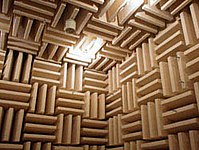
Photo from wikipedia
Besides improving speech intelligibility in background noise, another important objective of noise reduction algorithms for binaural hearing devices is preserving the spatial impression for the listener. In this study, we… Click to show full abstract
Besides improving speech intelligibility in background noise, another important objective of noise reduction algorithms for binaural hearing devices is preserving the spatial impression for the listener. In this study, we evaluate the performance of several recently proposed noise reduction algorithms based on the binaural minimum-variance-distortionless-response (MVDR) beamformer, which trade-off between noise reduction performance and preservation of the interaural coherence (IC) for diffuse noise fields. Aiming at a perceptually optimized result, this trade-off is determined based on the IC discrimination ability of the human auditory system. The algorithms are evaluated with normal-hearing participants for an anechoic scenario and a reverberant cafeteria scenario, in terms of both speech intelligibility using a matrix sentence test and spatial quality using a MUlti Stimulus test with Hidden Reference and Anchor (MUSHRA). The results show that all the binaural noise reduction algorithms are able to improve speech intelligibility compared with the unprocessed microphone signals, where partially preserving the IC of the diffuse noise field leads to a significant improvement in perceived spatial quality compared with the binaural MVDR beamformer while hardly affecting speech intelligibility.
Journal Title: Trends in Hearing
Year Published: 2020
Link to full text (if available)
Share on Social Media: Sign Up to like & get
recommendations!